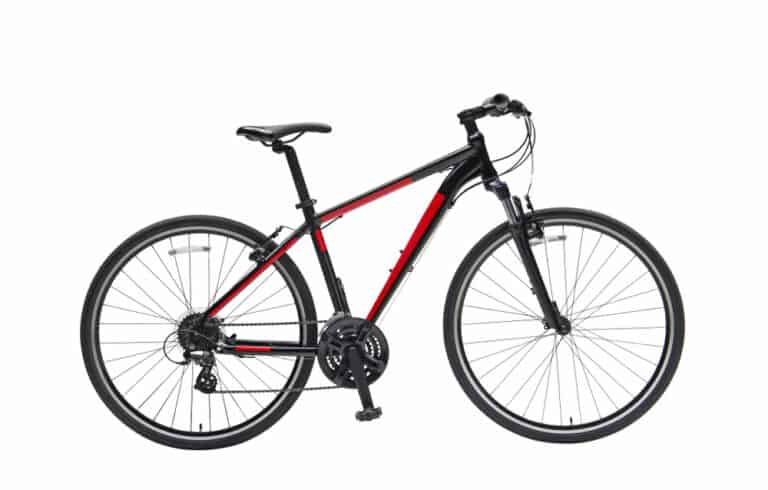Calories Burned Biking 10 Miles

As a weight loss exercise, cycling is one of the more efficient methods to burn calories, plus the fact that it is an impact-free form of exercise-unless you fall off, of course- makes it a convenient and efficient way to burn calories – but how many calories would you burn biking 10 miles?
Calories burned biking 10 miles will depend on your weight and speed, so a 150lb rider with an average speed of 12mph would burn around 476 calories over 10 miles, while a 200lb rider would burn 635 calories over the same distance at the same average speed.
To get a deeper insight into the mechanics of burning calories while biking, we need to look at all the various elements like why heavier riders burn more calories biking 10 miles, how speed affects the number of calories burned, and how long and fast you’d have to ride to burn one pound of body fat – so let’s get in the saddle and ride!
Why The Calories Burned Biking 10 Miles Depends On Your Weight
To answer this question thoroughly, you need to understand the relationship between the weight of the rider, the number of calories burned, and the effect speed has on the energy used during a ride.
For this example, we will look at five different riders averaging the same speed of 12mph and see how much heavier riders burn more calories than those that weigh less. The table below shows riders of 150lbs, 175lbs, 200lbs, 225lbs, and 250 lbs, all riding 10 miles at the same speed.
| Rider Weight | 150lbs | 175lbs | 200lbs | 225lbs | 250lbs |
| 10 miles/16km | 476 cal | 556 cal | 635 cal | 715 cal | 794 cal |
You can already see a significant and noticeable difference in the number of calories burned by the 250lb rider vs. the 150lb rider.
When you compare the calories burned by the 150lb rider (476 calories) and the 250lb rider (794). In that case, this is a difference of 318 calories which is 66% more calories, and congruently is the same percentage difference in weight of 100lbs between a 150lb rider and 250lb rider.
This happens because a heavier rider requires more effort to propel the bike forwards, and this is due to the effects of gravity and friction on the rider. So, the lighter you are, the less energy you need to ride, and the heavier you are, the more power you need.
While you may think that the heavier rider benefits more from burning more calories than the lighter rider, remember that calories burned are relative to weight, so the calorie-to-body weight ratio is the same.
If you divide the calories burned by the weight of the 150lb rider, you get a ratio of 3,176 calories/pound, and you will get the same ratio dividing the weight of the 250lb rider by the calories burned biking for 10 miles at the same speed.
So if you want to know how many calories you would burn biking 10 miles at 12mph, take your weight and multiply it by 3,176.
This is a fairly accurate figure, but using an app that takes your weight and height and the profile of your ride, like the amount of climbing, will give you a more accurate picture of the calories burned over a 10-mile ride.
This leads to an interesting analysis of professional riders like those that ride the Tour De France, so let’s take a quick look at the average weight, speed, and calories burned by professional cyclists.
What Is The Average Weight Of A Tour De France Rider
The average weight for a pro rider in the TDF is 155 lbs, with the lightest rider weighing in at a feathery 136 lbs and the heaviest at about 164lbs. If you consider those weights, you will see that the riders that specialize in climbing weigh the least, and the sprinters weigh the most.
This is because climbing requires more efficiency and less weight to be faster up hills, and the added weight creates more momentum and speed on the downhills.
What Is The Average Speed In The TDF
When it comes to average speed, a Tour De France rider will average around 25mph per stage, and when you consider that some climbs are incredibly steep and long, averaging 25mph on the ascents, flats, and descents is no mean feat!
Combining this with the stage distances, duration, and ascent and descent profiles, you can easily see that a TDF rider would burn many calories over a stage.
How Many Calories Does A Tour Rider Burn In A Stage
When it comes to calories burned, these guys and girls are in a different class altogether, and riders in a single stage in the TDF can burn up to 6000 calories, and over the event, that will be around 120 000 calories!
When you consider the difference between 12mph average and 25mph average speeds in calories burned, it’s clear that speed plays a major role in how many calories you would burn biking 10 miles, so let’s examine that in more detail.
The Effect Of Your Average Speed On Calories Burned
For the first part of this discussion on calories burned biking 10 miles, we allocated an average speed of 12mph for riders of varying weights; now, we are going to look at the effect that increasing your speed would have on the number of calories burned over the same distance.
The table below shows how the number of calories burned increases with just a two mph increase in speed for riders at each weight riding for one hour.
| 150 lbs | 175 lbs | 200 lbs | 225 lbs | 250 lbs | |
| 12 mph | 572 cal | 667 cal | 762 cal | 857 cal | 953 cal |
| 14mph | 714 cal | 833 cal | 953 cal | 1072 cal | 1191 cal |
| 16mph | 857 cal | 1000 cal | 1143 cal | 1286 cal | 1429 cal |
By increasing your average speed by just two mph from 12mph to 14mph, which is only 14%, the calories burned increase by 25%, and if you increase that to 16mph from 12mph, that rises to almost 50% more calories burned.
However, increasing your average speed requires greater fitness and stamina and better pedaling technique and mechanics, so this will take time. Still, if you ride regularly and work slowly to improve your speed, you can burn more calories as you go faster.
Remember also that at 12mph, a 10-mile ride would be less than an hour and take around 50 minutes to complete, which means over 10 miles at 12 mph, you would burn 474 calories as a 150lb rider.
How Far And Fast Would You Ride To Burn Off One Pound Of Body Fat
Since many recreational riders use cycling to burn calories and lose weight, how long and far would you need to ride to burn off one pound of body fat?
Well, there are 3500 calories in one pound of body fat, and to burn that off on a bike, you would need to put in some serious miles at a decent speed!
For example, a 150 lb rider averaging 16mph would need to ride for four hours or 64 miles to burn one pound of body fat, and that would jump to six hours or 72 miles if the average speed were 12mph.
A 200lb rider averaging 12mph would have to ride for more than 4,5 hours or 55 miles to burn 3500 calories, and at an average speed of 16mph, that figure would be just over 3 hours or 48 miles.
For the heavier riders, the time and distances are shorter, but far more effort would be needed, so at 12 mph, a 250lb rider would need to ride for 3,6 hours or 44 miles, and if that average speed were 16mph, then the time in the saddle would be around 2, hours or about 40 miles.
Remember that climbing takes more energy, so if you want to boost your calorie burn on your ride, add plenty of ascents. While these climbs are strenuous, the downhills are great fun, and you can take a rest while zipping down the descents.
How Many Calories Per Mile Would You Burn Biking 10 Miles
If you want an idea of the number of calories per mile, you would burn over ten miles, take your body weight and average speed and use the table to calculate your average calories per mile ratio.
A 150lb rider averaging 12mph would burn 476 calories over 10 miles or 47,6 calories per mile. A 200lb rider at the same average speed would burn 63,5 calories per mile, and a 250lb rider at the same speed would burn around 79,4 calories per mile.
Remember that 12mph is a fairly low average speed, so if you know your average speed will be higher and what that figure would be, you can easily determine your calories burned per mile when biking 10 miles.
As a side note, starting with a five-mile ride and building up to ten miles is an excellent start if your goal is to lose weight. Still, the ride duration greatly impacts how many calories you burn, so to kick that up a gear, push your rides longer while keeping your speed up and watch that calorie burn count skyrocket!

Conclusion
Biking 10 miles at a reasonable average speed will burn calories. Because cycling is a low-impact sport that produces far less stress on the body than running, many people take up riding as an effective way to lose weight and burn calories.
The rule of thumb with calories burned biking 10 miles is the faster you go, the more calories you burn, and the more climbing you do, the more calories you burn – so speed, hills, and riding time are the three primary keys to burning more calories when riding.






